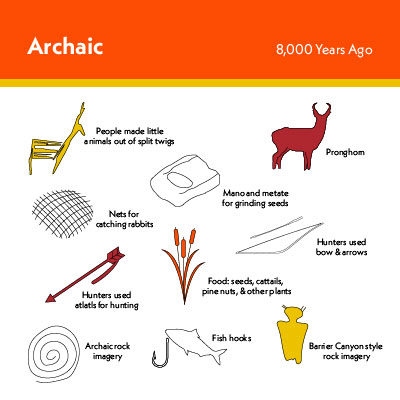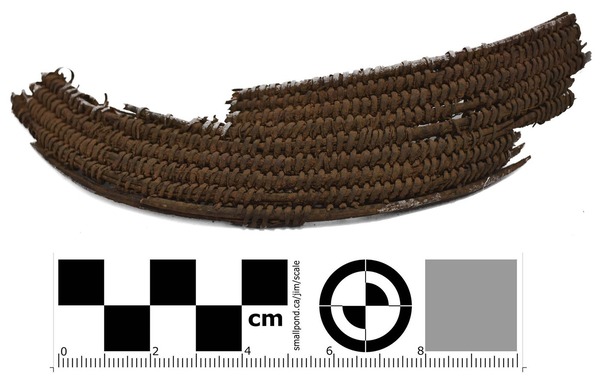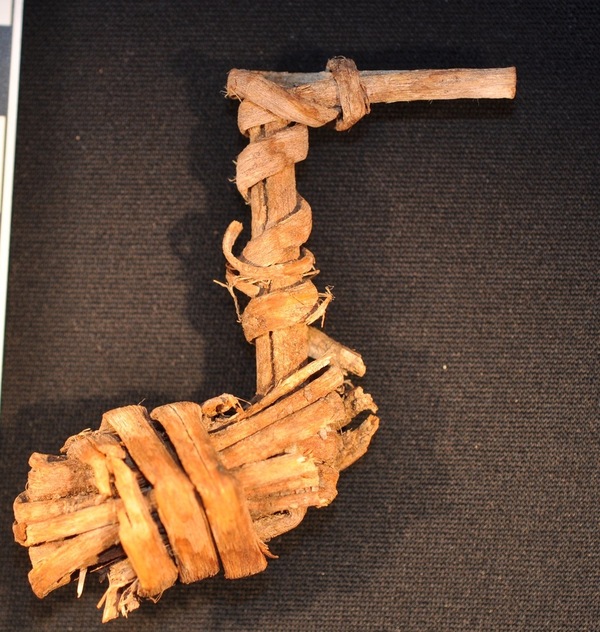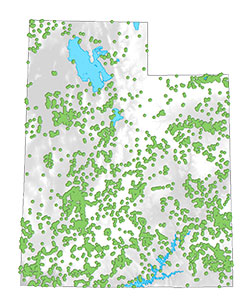By Savanna Agardy
7,000 BC — 500 BC

Beginning the Archaic Period
The Archaic Period is the longest archaeology time period in Utah’s history, lasting around 8,000 years! Archaic people lived in different ways than Paleoindian people because the climate changed. It became hotter and drier, causing plants and animals to change. Archaic people still traveled across the land hunting and gathering, but their lifestyles were different from Paleoindian people before them.
Since the Archaic Period was so long, archaeologists divide it into three time periods: the Early Archaic, Middle Archaic, and Late Archaic.

Early Archaic
People began to process and store food in the Early Archaic Period. Archaeologists know this because they have found grinding stones and baskets from this era. Baskets were made to store the seeds and roots people collected. They used grinding stones, or manos and metates, to grind seeds and roots into flour. Flour could be cooked into a porridge using hot rocks and topped with meat and greens.
Early Archaic people lived in small groups, much like Paleoindian people. As the climate was changing, many of Utah’s valleys were still covered in wetlands, although they were getting smaller due to the hotter and drier environment. Nevertheless, wetlands still offered many types of plants and animals to eat. Like Paleoindian people, during the Early Archaic period people traveled around following seasonal food sources and living near water. Early Archaic people also made jewelry and musical instruments like flutes!

Middle Archaic
The Middle Archaic was a tougher time to live than the Early Archaic. The wetlands which had provided food and water dried up, making it harder to hunt animals, gather plants, and find other resources. Archaeologists have found a very small number of sites from the Middle Archaic period, which indicates that populations in Utah probably went down during this time.
People still lived the hunter-gatherer way of life, but had to be more deliberate in their search for food and water. One cave near the Great Salt Lake shows that Middle Archaic people ate grasshoppers. Grasshoppers that had been blown onto the shores of the lake provided a salted and delicious snack for people of this time.

Late Archaic and Ending the Archaic Period
Things changed for the better after the difficult Middle Archaic. During the Late Archaic period, the climate grew wetter again, the wetlands came back, and populations grew. People started to live in large clusters rather than in small groups. The famous bow and arrow was invented in the Late Archaic period, changing the way people hunted.

Trade and migrations of different peoples from the south brought even more dramatic changes for Late Archaic people living in this region. The newcomers introduced farming technologies and new foods from Central America. People living in Utah began to grow corn, beans, and squash, and developed great skills in irrigation and cultivation. This brought about major changes in Late Archaic lifestyles. People no longer lived a full-time hunter-gatherer way of life. They chose to live near their crops rather than migrate to follow their food. As their foodways changed, their diets and other parts of their culture changed too.
Archaeologists mark two new cultural periods in Utah that began when people adopted farming: Fremont and Ancestral Puebloan.
Fremont people are directly descended from the people who lived in Utah during the Late Archaic period. Fremont people lived and farmed all over Central and Northern Utah.
Ancestral Puebloan people migrated into what is now Southern Utah and the Four Corners region, where they settled, farmed, and built houses and villages that we can still see today.